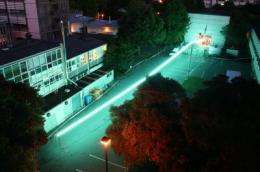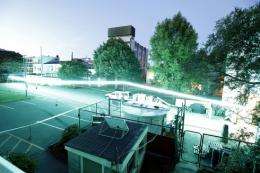High-voltage engineers create nearly 200-foot-long electrical arcs using less energy than before (Update)

Photos taken by the researchers show plasma arcs up to 60 meters long casting an eerie blue glow over buildings and trees at the High Voltage Laboratory at the University of Canterbury in New Zealand.
A team of engineers at Canterbury University in New Zealand has developed a method to create nearly 200-foot-long electrical arcs -- visible currents of electricity traveling through air that has been broken down into electrically charged particles. Others have created longer arcs, but the traditional technique requires large amounts of energy in order to break down the air.
The new technique requires much less energy. In it, an arc travels along the path of a thin copper wire. At 0.2 mm, the wire is a little larger than the diameter of an average human hair. The wire explodes when a voltage is applied, creating a burst of light that lasts for about as long as an average camera flash, less than one thousandth of a second, and a plasma, a gas of charged particles.
Daniel Sinars, who researches fusion at Sandia National Laboratory in Albuquerque, N.M., has also worked with exploding wires, but at a much smaller scale. He found the arcs produced by the New Zealand researchers interesting.
"It's hard to make a plasma that size," said Sinars.
The team occasionally created plasma arcs during other exploding wire experiments and pursued the new research in order to better understand how the arcs formed.

"We are fascinated by the plasma associated with electrical arcs," team members Wade Enright and Rowan Sinton wrote in an email to Inside Science. "We want to be able to create plasma in ways which allow us to study and apply it."
The researchers noted that the potential applications of this research include improving understanding of lightning, potentially through "artificially inducing lightning from thunderclouds," they said.
This would interest scientists because collecting data about lightning is difficult if it strikes randomly. Induction could be used to direct lightning to research equipment.
The New Zealand team is also developing coils and knots of plasma to study ball lightning, as well as other topics.
They estimate that hundreds of facilities around the world have the necessary equipment to create arcs the length of multiple football fields, and that perhaps a dozen have the capacity to create an arc of 1.2 miles.
A paper detailing the findings is scheduled to be published in the Journal of Applied Physics.
From now on, you can follow Physorg on Google+ too!
More information: "Generating Extra Long Arcs Using Exploding Wires" is accepted for publication in the Journal of Applied Physics.
Source: Inside Science News Service





















